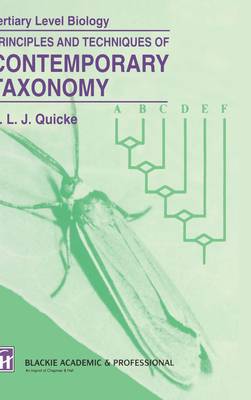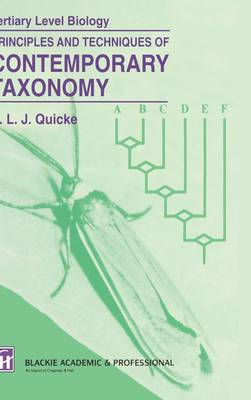
Je cadeautjes zeker op tijd in huis hebben voor de feestdagen? Kom langs in onze winkels en vind het perfecte geschenk!
- Afhalen na 1 uur in een winkel met voorraad
- Gratis thuislevering in België vanaf € 30
- Ruim aanbod met 7 miljoen producten
Je cadeautjes zeker op tijd in huis hebben voor de feestdagen? Kom langs in onze winkels en vind het perfecte geschenk!
- Afhalen na 1 uur in een winkel met voorraad
- Gratis thuislevering in België vanaf € 30
- Ruim aanbod met 7 miljoen producten
Zoeken
Omschrijving
1 Introduction.- 1.1 The compass of taxonomy and systematics.- 1.2 The 1960s and the emergence of new ideas.- 1.3 Cladistics and numerical taxonomy: the conflict.- 1.4 Assumptions and philosophy of cladistics and the use of parsimony criteria.- 1.5 Taxonomy and the comparative method in biology.- 2 Characters, Taxa and Species.- 2.1 Nature and handling of data.- 2.2 Characters.- 2.2.1 Discrete coding of continuous characters and ratios.- 2.2.2 Identifying primitive and advanced character states.- 2.2.3 Homoplasy: convergence, parallelisms and reversals.- 2.2.4 Homology versus analogy.- 2.2.5 Character state transitions.- 2.2.6 Dealing with missing data and polymorphic characters.- 2.3 Classes of characters requiring special consideration.- 2.3.1 Characters subject to strong selection pressures.- 2.3.2 Environmental effects.- 2.3.3 Molecular sequence characters.- 2.3.4 Electron microscopy and the use of microcharacters.- 2.3.5 Colour as a taxonomic character.- 2.3.6 Cryptic and internal characters.- 2.3.7 Animal artefacts.- 2.3.8 Behavioural characters.- 2.4 Taxa and species concepts.- 2.4.1 Phylogenetic groups: monophyly, polyphyly and paraphyly.- 2.5 What is a species?.- 2.5.1 Biological species concept.- 2.5.2 Phvlogenetic species concept.- 2.5.3 Evolutionary species concept.- 2.5.4 Problems with parthenogenetic species and asexual clones - some further considerations.- 3 Phylogenetic Reconstruction - Cladistics and Related Methods.- 3.1 Cladistics and cladograms.- 3.1.1 Parsimony.- 3.1.2 Compatibility analysis.- 3.1.3 Maximum likelihood and related methods.- 3.2 Parsimony and finding the shortest trees.- 3.2.1 Finding the shortest trees and the impact of computerization.- 3.2.2 Tree facts and figures.- 3.2.3 Building trees from distance data.- 3.2.4 Rooting trees.- 3.2.5 Consistency and other indices.- 3.2.6 Weighting characters.- 3.2.7 Coping with multiple trees.- 3.2.8 Consensus trees.- 3.2.9 Comparing trees.- 3.3 Which method? - an overview.- 3.3.1 How well does parsimony analysis estimate trees?.- 3.3.2 Compatibility versus parsimony.- 3.3.3 Congruence between data sets (or how do we know when to believe a phylogeny?).- 3.3.4 Reticulate evolution, hybrids and intraspecific evolution.- 3.4 Cladistics and classification.- 4 Phenetic Methods in Taxonomy.- 4.1 Introduction.- 4.1.1 Similarity and distance measures.- 4.1.2 Measures using binary characters.- 4.1.3 Distance and similarity measures using continuous data.- 4.2 Analysing similarity and distance data.- 4.3 Hierarchic clustering procedures.- 4.3.1 Nearest neighbour clustering.- 4.3.2 Furthest neighbour (complete linkage).- 4.3.3 Unweighted pair-group method using arithmetic averages (UPGMA).- 4.3.4 Weighted pair-group method using arithmetic averages (WPGMA).- 4.3.5 Centroid clustering.- 4.4 Ordination methods.- 4.4.1 Principal components analysis.- 4.4.2 Principal coordinate analysis.- 4.4.3 Canonical variate analysis.- 4.4.4 Non-metric multidimensional scaling.- 5 Keys and Identification.- 5.1 Introduction.- 5.1.1 Purpose of keys.- 5.1.2 Good practice in writing keys.- 5.2 Types of keys.- 5.2.1 Dichotomous keys.- 5.2.2 Multiple-entry keys.- 5.3 Efficiency.- 5.3.1 Length of dichotomous keys.- 5.3.2 Reliability.- 5.3.3 Choice of characters.- 5.3.4 Likelihood of encountering taxon.- 5.4 Computerized key construction.- 5.4.1 Interactive identification.- 5.4.2 Matching.- 5.4.3 Automated taxon descriptions.- 5.4.4 Databases.- 6 Nomenclature and Classification.- 6.1 Introduction.- 6.2 The binomial system and the hierarchy of taxa.- 6.3 The International Commissions.- 6.3.1 Codes of nomenclature.- 6.3.2 Independence of the Codes.- 6.4 Basic principles of nomenclature.- 6.4.1 Priority.- 6.4.2 Synonymy.- 6.4.3 Homonymy.- 6.4.4 The type concept.- 6.5 Miscellaneous group-related factors.- 6.5.1 Animals and animal-like Protista.- 6.5.2 Plants and plant-like Protista.- 6.5.3 Fungi.- 6.5.4 Lichens.- 6.5.5 'Blue-green algae' (Cyanophyta versus Cyanobacteria).- 6.5.6 Bacteria a...
Specificaties
Betrokkenen
- Auteur(s):
- Uitgeverij:
Inhoud
- Aantal bladzijden:
- 324
- Taal:
- Engels
- Reeks:
Eigenschappen
- Productcode (EAN):
- 9780751400199
- Verschijningsdatum:
- 15/07/1993
- Uitvoering:
- Hardcover
- Formaat:
- Genaaid
- Afmetingen:
- 152 mm x 229 mm
- Gewicht:
- 644 g

Alleen bij Standaard Boekhandel
+ 302 punten op je klantenkaart van Standaard Boekhandel
Beoordelingen
We publiceren alleen reviews die voldoen aan de voorwaarden voor reviews. Bekijk onze voorwaarden voor reviews.









